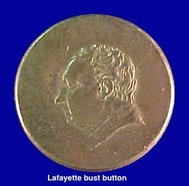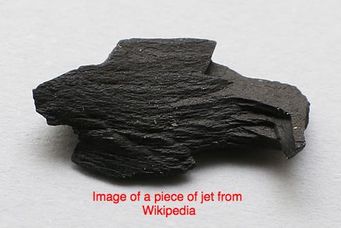
Below is a list of categories from which you can choose a favorite "L" or "M" button(s) to bring for "Show 'N Tell.". If there is not a website link with the description, you can try google-ing the term and add the word "images" to find photos of the type. Also look for lambs, liberty, lilacs, lucky, maidens, mosquitoes, metal, mothers, etc.
La Mode: Trade name found on buttons and button cards (re: B. Blumenthal & Sons). shop.buttons.com/la-mode-buttons-s/1955.htm
Lace Buttons: Handmade and machine-made lace used to over buttons. (Not many old ones survived because they weren’t practical.
Lacquered Buttons: Varnished buttons may be called “lacquered” or “japanned” interchangeably. However, true lacquer is mostly found on Oriental buttons and these are very rare. Often 15 coats of the lacquer was applied. The trees from which the lacquer comes is also found only in the Orient.
Lafayette Buttons: Made in honor of the Marquis de Lafayette’s second visit to the USA (1824). These portrait buttons became “en vogue” because up until then, coat buttons were plain. They stayed popular for several years. The engraver’s initials can be found below the collar: “Wt Ft.” There are also reproductions.
Lafayette Presentation Buttons: Buttons presented to Lafayette during his 1824 visit. to the USA. Made of native North Carolinian gold. Ten of those original buttons are in a museum in France. The title: Lafayette Presentation Buttons is also used when referring to one-piece gilt buttons with the image of the head of George Washington on them. These were made by the Scovill Manufacturing Company.
Laminated Buttons: Term sometimes used for marquetry or inlay buttons. Not common.
Lane Manufacturing Company: Waterbury, Conn. (1840’s-1924) Mostly made picture buttons, especially the Red Riding Hood pattern. Not marked…difficult to verify.
Lapis Lazuli: This gemstone was rarely used for buttons but when found, they have a long shank indicating that they were used on men’s waistcoats in the early 19th century.
Le Chic: Trade name found on buttons and button cards (re: B. Blumenthal & Sons).
Leather Buttons: Except for leather ”knot” buttons, not many buttons have been made of leather. In the 20th century some novelty leather buttons were made. Embossed leather was used in the 19th century on wood and metal buttons, as was a coated paper stamped with a leather design.
Leavenworth & Kendrick: Made gilt buttons between 1829 and 1837. Backmark.
Leek Buttons: Handmade of silk thread in basket weave patterns in Leek, England. Used on men's clothing—mostly black.
Leo Popper & Sons: Maker and importer (along with his son and brothers) of glass buttons. Popper buttons were round, cone-shaped, highly domed, slightly convex, square, oblong or oval. Sized 1/2” to almost 2”. www.gannonsantiques.com/antique-buttons.html
Lewis, Grilley & Lewis: American Button makers (1820s) Name appears on early gilt and uniform buttons.
Lidz Bros., Inc.: 1945 to today. New York button importers and wholesalers for dress-making trade and chainstore trade. Principally known as Costumakers but also use brand names such as Stylerite, Stylemakers, Fashion-Mates, Fashion-Aire, Courtier by Costumakers. Lidz name can be found on button backs sometimes. www.etsy.com/search?q=lidz+buttons
Lincoln Buttons: Wire-shanked, narrow-rimmed, ferrotype buttons with Lincoln images were made as campaign buttons, but are scarce. A memorial black horn button was made with the busts of Washington and Lincoln on it. Difficult to put a date or use on these buttons as well as period authenticity.
Lind, Jenny Buttons: The profile of this famous singer was a favorite subject for buttons. Most plentiful are small jewel types featuring her profile. The molded glass centers were made of a variety of colors. Black glass Jenny Lind buttons are the easiest to find today. www.pinterest.com/pin/192036371582684252/
Link Buttons: A rare type of button with wire shanks that at one time was a standard type of button. Sometimes made of silver and face of button was highly decorated. Worn on men’s coats and breeches.
Linoleum Buttons: Linoleum buttons with brightly colored scenes were made in Mexico. Scarce.
Lithograph Buttons: Colored pictures on paper found in metal frames.Made between 1880 and 1910.
Liverpool Transfer Buttons: Black, sepia or polychrome transfer designs on porcelain which is surrounded by metal. Mostly featured heads and are now rare.
Livery Buttons: From the middle of the 18th century on, mostly featuring a man’s personal crest. Basically of metal. Not too hard to find. Horn livery buttons were worn during mourning.
Locket Buttons: US locket-style uniform buttons in two styles: WWI and WWII. WWI button is dark brown metal government-issue button with front and back fastened with a hinge. When opened, it featured two places for photos. WWII: also referred to as compass buttons because they have a compass inside. They look like an officer’s regular gilt buttons. Other locket buttons have been produced for the British military. All locket buttons are extremely rare. jillionsofbuttons.blogspot.com/2012/09/army-locket-button.html
Lucite Buttons: Trade name for a clear plastic used in the 20th century. The Lucite names refers to a specific company but collectors often use the term to label all clear plastic buttons. It is very hard to distinguish one clear plastic buttons manufacturer’s products from another.
Luster Buttons: Iridescent, silver, gold, copper, bronze and gunmetal metallic finish used to decorate buttons. The finish appears the most on black glass buttons and the silver luster is the most common finish used. Date back to mid 19th century to current times.
Marcasite Buttons: Some questions remain as to whether marcasite was actually used rather than some other pyrite beginning in 1845, when buttons were made with “marcasite” trim. Marcasite was always set in metal cups (usually silver). Extremely rare.
Marquetry buttons: Thin inlay decorations on flat button surfaces, like a veneer. Used on almost every button material except metal and glass. Also referred to as inlays or inlaid buttons.
Mask Buttons: Oriental ceramic buttons featuring masks (often from Noh dramas). Painted in bright colors.
Mathew, Anson Buttons: A. Mathew pewter buttons are among the most commonly found pewter buttons. They have the name as a backmark and wire shanks.
Mexican Silver Buttons: One- and two-piece silver buttons with gemstones made in Mexico. More jewelry was made at the small factories, so buttons are harder to find.
Meyers, H.M.: An artist in the 40s who hand-painted large porcelain buttons with self-shanks. Sold in a New jersey shop.
Military Buttons: Buttons made for uniforms of the various branches of the US date from about the 1700s to the present.
Mirror Buttons: (Glass buttons) Constructed like kaleidoscope buttons but had silver only on the back of the glass to produce a reflection. A metal shank plate and wire shank covered the back. Mostly made with clear glass with a cut similar to Victorian mirrors.
Moonglow/Moonstone Buttons: Trade names for two similar types of glass buttons made in 20th century. Constructed to create a light that glows in a way that makes the button resemble the moonstone gem. It is difficult to differentiate a moon glow from a moonstone product. Generally called iridescent glass. www.wtv-zone.com/julia801/Site/Moonglows.html
Morley Manufacturing Company: Made Milonite and Ebonite buttons made from paper, which they called fiber. Bright and colorful clothing and shoe buttons.
Mosaic Buttons: During Victorian times, the customary designs created with tiny bits of glass or stone were buildings and buildings ruins. Some scenes, flowers and animals have been found. The best were ground flat and polished, Some 20th century mosaic buttons have been left rough on top. www.etsy.com/listing/237684057/set-six-antique-micro-mosaic-buttons?ref=market
Mother-of-Pearl Buttons: For years, manufacturers have called buttons made from some deep-sea shells “mother-of-pearl buttons.” It is very hard to classify the type of shell used once the button was made and actual shell was discarded. More prized than fresh-water shell buttons because the original brilliance of those shells is not as great as deep-sea shells and they dull faster.
Mourning Buttons: A term used for black glass buttons with a dull finish.
Mythological Design Buttons: Popular mythological stories and old gods used as decoration mostly in the 19th century on metal buttons.

 RSS Feed
RSS Feed